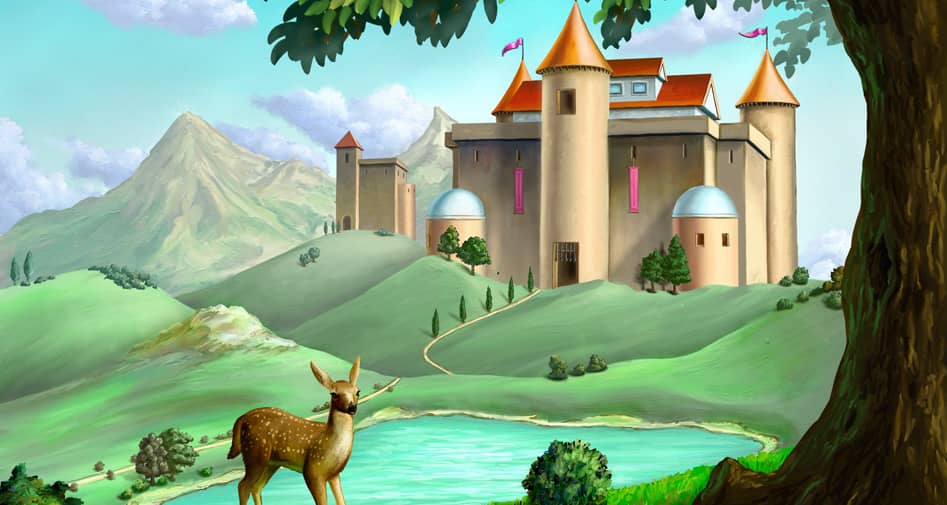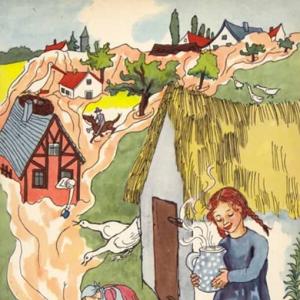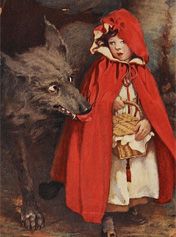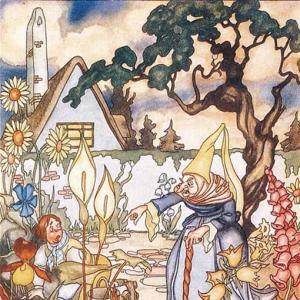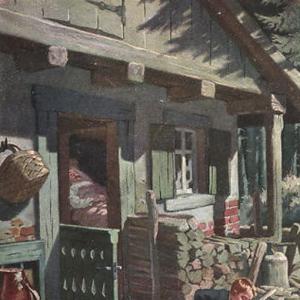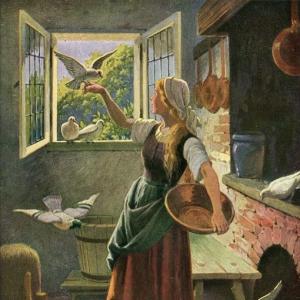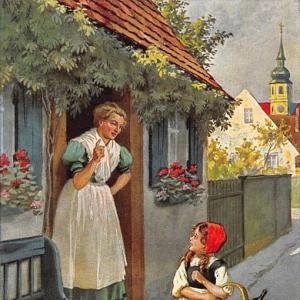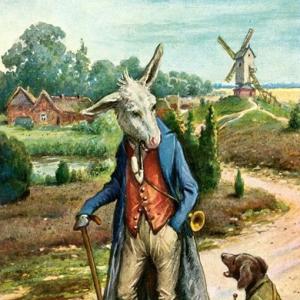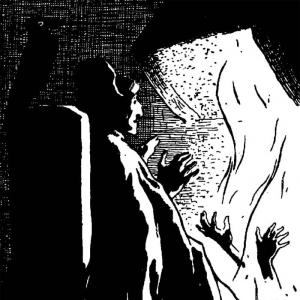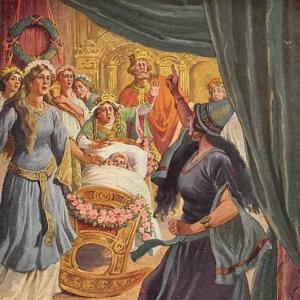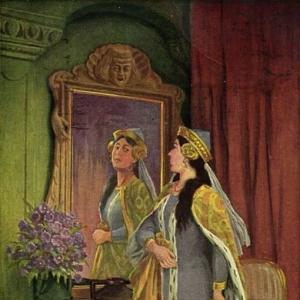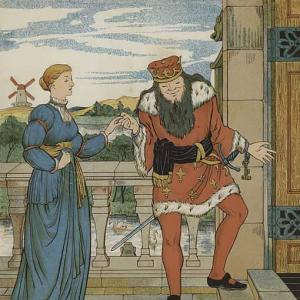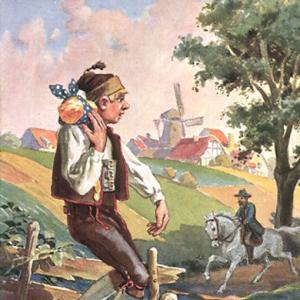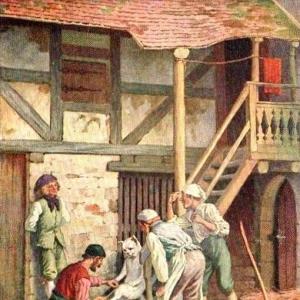Reading time for children: 24 min
There was an old manor house where a young, splendid family lived. They had riches and many blessings. They liked to enjoy themselves, and yet they did a lot of good. They wanted to make everybody happy, as happy as they themselves were.
On Christmas Eve a beautifully decorated Christmas tree stood in the large old hall, where fire burned in the fireplaces and fir branches were hung around the old paintings. Here gathered the family and their guests; here they sang and danced.
The Christmas festivities had already been well under way earlier in the evening in the servants‘ quarters. Here also stood a large fire tree, with lighted red and white candles, small Danish flags, swans and fishing nets cut out of colored paper and filled with candies and other sweets. The poor children from the parish had been invited, and each had its mother along. The mothers didn’t pay much attention to the Christmas tree, but looked rather at the Christmas table, where there lay woolen and linen cloths, for dresses and trousers. Yes, the mothers and the older children looked at this; only the smallest children stretched out their hands toward the candles, the tinsel, and the flags. This whole gathering had come early in the afternoon. They had been served Christmas porridge and roasted goose with red cabbage. Then when the Christmas tree had been looked over and the gifts distributed, each got a small glass of punch and apple-filled æbleskiver.
When they returned to their own humble rooms, they talked about the „good living,“ by which they meant the good food they had had, and the presents were again thoroughly inspected.
Now, among these folks were Garden-Kirsten and Garden-Ole. They were married, and earned their lodging and their daily bread by weeding and digging in the manor house garden. At every Christmas party they received a goodly share of the gifts, but then they had five children, and all five of them were clothed by the wealthy family.
„Our masters are generous people,“ they said. „But then they can afford it, and they get pleasure out of it.“
„The four children received some good clothing to wear,“ said Garden-Ole, „but why is there nothing here for the Cripple? They always used to think of him, too, even if he wasn’t at the party.“
It was the eldest of the children they called the Cripple, although his name was Hans. When little, he had been the most able and the liveliest child, but all of a sudden he had become „loose in the legs,“ as they called it. He could neither walk nor stand, and now he had been lying in bed for nearly five years.
„Yes, I got something for him, too,“ said the mother. „But it’s nothing much. It is only a book for him to read!“
„That won’t make him fat!“ said the father.
But Hans was happy for it. He was a very bright boy who enjoyed reading, but who also used his time for working, doing as much as he, who always had to lie bedridden, could, to be of some benefit. He was useful with his hands, knitted woolen stockings, and, yes, even whole bedcovers. The lady at the manor house had praised him and bought them. It was a book of fairy tales Hans had received. In it there was much to read and much to think about.
„It is of no use here in this house,“ said the parents, „but let him read, for it passes the time, and he can’t always be knitting stockings.“
Spring came; green leaves and flowers began to sprout, and the weeds, too, as one may call the nettles, even if the psalm speaks so nicely about them:
If every king, with power and might,
Marched forth in stately row,
They could not make the smallest leaf
Upon a nettle grow. There was much to do in the manor house garden, not only for the gardener and his apprentices, but also for Garden-Kirsten and Garden-Ole.
„It’s a lot of hard work,“ they said. „No sooner have we raked the walks, and made them look nice, than they are stepped on again. There is such a run of visitors at the manor house. How much it must cost! But the owners are rich people!“
„Things are strangely divided,“ said Ole. „We are our Lord’s children, says the pastor. Why such a difference, then?“
„That comes from the fall of man!“ said Kirsten.
In the evening they talked about it again, while Cripple-Hans was reading his book of fairy tales. Hard times, work, and toil had made the parents not only hard in the hands but also hard in their judgment and opinion.
They couldn’t understand, and consequently couldn’t explain, the matter clearly, and as they talked they became more peevish and angry.
„Some people are prosperous and happy; others live in poverty. Why should we suffer because of our first parents‘ curiosity and disobedience! We would not have behaved as those two did!“
„Yes, we would!“ said Cripple-Hans all of a sudden. „It is all here in this book!“
„What’s in the book?“ asked the parents.
And Hans read for them the old fairy tale about the woodcutter and his wife. They, too, argued about Adam’s and Eve’s curiosity, which was the cause of their misfortune also. The king of the country then came by. „Follow me home,“ he said, „and you shall be as well off as I, with a seven-course dinner and a course for display. That course is in a closed tureen, and you must not touch it, for if you do, your days of leisure are over!“ – „What can there be in the tureen?“ said the wife. „That’s none of our business,“ said the husband. „Well, I’m not inquisitive,“ said the woman, „but I would like to know why we don’t dare lift the lid. It must be something delicious!“ – „I only hope there is nothing mechanical about it,“ said the man, „such as a pistol shot, which goes off and awakens the whole house!“ – „Oh, my!“ said the woman, and she didn’t touch the tureen. But during the night she dreamed that the lid lifted itself, and from the tureen came an odor of the most wonderful punch, such as is served at weddings and funerals. In it lay a large silver coin bearing the following inscription, „If you drink of this punch, you will become the two richest people in the world, and all other people will become beggars!“ Just then the woman awoke and told her husband about her dream. „You think too much about that thing,“ he said. „We could lift it gently,“ said the woman. „Gently,“ said the man. And the woman lifted the lid very, very gently. Then two small, sprightly mice sprang out and disappeared into a mousehole. „Good night,“ said the king. „Now you can go home and lie in your own bed. Don’t blame Adam and Eve any more. You two have been just as inquisitive and ungrateful!“
„Where has that story in the book come from?“ said Garden-Ole. „It sounds as if it were meant for us. It is something to think about.“
The next day they went to work again, and they were roasted by the sun and soaked to the skin by the rain. Within them were grumbling thoughts as they pondered over the story.
The evening was still light at home after they had eaten their milk porridge.
„Read the story about the woodcutter to us again,“ said Garden-Ole.
„But there are so many other beautiful stories in this book,“ said Hans, „so many you don’t know.“
„Yes, but those I don’t care about!“ said Garden-Ole. „I want to hear the one I know!“
And he and his wife heard it again.
More than one evening they returned to that story.
„It doesn’t quite make everything clear to me,“ said Garden-Ole. „It’s the same with people as it is with sweet milk when it sours. Some becomes fine cheese, and the other, only the thin, watery whey. So it is with people. Some are lucky in everything they do, live high all their lives, and know no sorrow or want.“
This Cripple-Hans heard. His legs were weak, but his mind was bright. He read for them from his book of fairy tales, read about “ The Man Without Sorrow and Want.“ Yes, where could he be found, for found he must be! The king lay on his sickbed and could not be cured unless he wore the shirt that had belonged to, and been worn on the body of, a man who could truthfully say that he had never known sorrow or want. A command was sent to every country in the world, to all castles and manors, to all prosperous and happy people. But upon thorough questioning, every one of them was found to have known sorrow and want. „I haven’t!“ said the swineherd, who sat laughing and singing on the edge of the ditch. „I’m the happiest person!“ – „Then give us your shirt,“ said the messengers. „You will be paid for it with half of a kingdom.“ But he had no shirt at all, and yet he called himself the happiest person!
„He was a fine fellow!“ shouted Garden-Ole, and he and his wife laughed as they hadn’t laughed for years.
Then the schoolmaster came by.
„How pleased you are!“ he said. „That is unusual in this house. Have you won a prize in the lottery?“
„No, it isn’t that sort of pleasure,“ said Garden-Ole. „It is because Hans has been reading to us from his book of fairy tales. He read about ‚ ‚The Man Without Sorrow and Want,‘ and that fellow had no shirt. Your eyes get moist when you hear such things, and from a printed book, at that! Everyone has a load to carry. One is not alone in that. That, at least, is a comfort!“
„Where did you get that book?“ asked the schoolmaster.
„Our Hans got it at Christmastime over a year ago. The manor house family gave it to him. They know he likes reading and, of course, that he is a cripple. At the time, we would rather have seen him get two linen shirts. But that book is unusual. It can almost answer one’s thoughts.“
The schoolmaster took the book and opened it.
„Let’s have the same story again,“ said Garden-Ole. „I don’t quite get it yet. And then he must also read the one about the woodcutter.“
These two stories were enough for Ole. They were like two sunbeams pouring into that humble room, into the oppressed thoughts that had made them cross and grumbly. Hans had read the whole book, read it many times. The fairy tales carried him out into the world, where he, of course, could not go because his legs would not carry him. The schoolmaster sat beside his bed. They talked together, and both of them enjoyed it.
From that day on, the schoolmaster visited Hans often when his parents were at work, and every time he came it was a great treat for the boy. How attentively he listened to what the old man told him – about the size of the world and about its many countries, and that the sun was nearly half a million times larger than the earth and so far away that a cannon ball in its course would take twenty-five years to travel from the sun to the earth, while the light beams could reach the earth in eight minutes. Of course, every studious schoolboy knew all that, but to Hans this was all new, and even more wonderful than what he had read in the book of fairy tales.
Two or three times a year the schoolmaster dined with the manor house family, and on one of these occasions he told of how important the book of fairy tales was in the poor house, how alone two stories in it had been the means of spiritual awakening and blessing, that the sickly, clever little boy had, through his reading, brought meditation and joy into the house. When the schoolmaster departed from the manor house, the lady pressed two shiny silver dollars in his hand for little Hans.
„Father and Mother must have them,“ said the boy, when the schoolmaster brought him the money.
And Garden-Ole and Garden-Kirsten both said, „Cripple-Hans, after all, is also a profit and a blessing to us!“
A couple of days later, when the parents were away at work at the manor house, the owners‘ carriage stopped outside. It was the kindhearted lady who came, happy that her Christmas gift had afforded so much comfort and pleasure to the boy and his parents. She brought fine bread, fruit, and a bottle of sweet sirup, but what was still more wonderful, she brought him, in a gilded cage, a little blackbird which whistled quite charmingly. The bird cage was placed on the old cabinet close by the boy’s bed. There he could see and hear the bird. Yes, and people way out on the highway could hear it sing.
Garden-Ole and Garden-Kirsten didn’t return home until after the lady had driven away. Even though they saw how happy Hans was, they thought there would only be trouble with the present he had received.
„Rich people don’t think very clearly,“ they said. „Now we have that to look after. Cripple-Hans can’t do it. In the end, the cat will get it!“
Eight days went by, and still another eight days. During that time the cat was often in the room without frightening the bird, to say nothing of not harming it.
Then one day a great event occurred. It was in the afternoon, while the parents and the other children were at work, and Hans was quite alone. He had the book of fairy tales in his hand and was reading about the fisherman’s wife who got her wishes fulfilled. She wished to be king, and that she became. She wished to be emperor, and that, too, she became; but then she wished to be the good Lord – and thereupon she again sat in the muddy ditch she had come from.
Now that story had nothing whatsoever to do with the bird or the cat, but it happened to be the story he was reading when this occurrence took place. He always remembered that afterward.
The cage stood on the cabinet, and the cat stood on the floor and stared, with its yellow-green eyes, at the bird. There was something in the cat’s look that seemed to say, „How beautiful you are! I’d like to eat you!“ That Hans understood. He could read it in the cat’s face.
„Get away, cat!“ he shouted. „You get out of this room!“
It looked as if the cat were getting ready to leap. Hans couldn’t reach it and had nothing to throw at it but his greatest treasure, the book of fairy tales. This he threw, but the cover was loose and flew to one side, while the book itself, with all its leaves, flew to the other side. The cat slowly stepped backward in the room and looked at Hans as if to say, „Don’t get yourself mixed up in this matter, little Hans! I can walk and I can jump. You can do neither.“
Hans was greatly worried and kept his eyes on the cat, while the bird also became uneasy. There wasn’t a person he could call. It seemed as if the cat knew that, and it prepared itself to jump again. Hans shook his bedcover at it – he could, remember, use his hands – but the cat paid no attention to the bedcover. And after Hans had thrown it without avail, the cat leaped up onto the chair and onto the sill. There it was closer to the bird.
Hans could feel his own warm blood rushing through his body, but that he didn’t think of. He thought only about the cat and the bird. The boy could not get out of bed without help; nor, of course, could he stand on his legs, much less walk. It was as if his heart turned inside him when he saw the cat leap straight from the window onto the cabinet and push the cage so that it overturned. The bird fluttered about bewilderedly in the cage.
Hans screamed; a great shock went through him. And without thinking about it, he sprang out of bed, moved toward the cabinet, chased the cat down, and got hold of the cage, where the bird was flying about in great fear. Holding the cage in his hand, he ran out of the door, onto the road. Then tears streamed from his eyes, and joyously he shouted, „I can walk! I can walk!“ He had recovered the use of his limbs. Such a thing can happen, and it had indeed happened to Hans.
The schoolmaster lived near by, and to him he ran on his bare feet, clad only in his shirt and jacket, and with the bird in the cage.
„I can walk!“ he shouted. „Oh, Lord, my God!“ And he cried out of sheer joy.
And there was joy in the house of Garden-Ole and Garden-Kirsten, „We shall never live to see a happier day,“ said both of them.
Hans was called to the manor house. He had not walked that road for many years. The trees and the nut bushes, which he knew so well, seemed to nod to him and say, „Good day, Hans! Welcome back out here!“ The sun shone on his face and right into his heart.
The owners of the manor house, that young, blessed couple, let him sit with them, and looked as happy as if he were one of their own family. But the happiest of the two was the lady, for she had given him the book of fairy tales and the little songbird. The bird was now dead, having died of fright, but it had been the means of getting his health back. And the book had brought the awakening to him and his parents. He still had it, and he wanted to keep it and read it, no matter how old he became. Now he also could be of help to his family. He wanted to learn a trade; most of all he wanted to be a bookbinder, „because,“ he said, „then I can get all the new books to read!“
Later in the afternoon the lady called both his parents up to her. She and her husband had talked about Hans – he was a fine and clever boy, with a keen appreciation of reading and a capacity for learning. Our Lord always rewards the good.
That evening the parents were really happy when they returned home from the manor house, especially Kirsten.
But the following week she cried, for then little Hans went away. He was dressed in good, new clothes. He was a good boy, but now he must travel far away across the sea, go to school, and learn Latin. And many years would pass before they would see him again.
The book of fairy tales he did not take with him, because his parents wanted to keep that in remembrance. And the father often read from it, but only the two stories, for those he understood.
And they had letters from Hans, each one happier than the last. He lived with nice people, in good circumstances. But best of all, he liked to go to school. There was so much to learn and to know. He only wished to live to be a hundred years old, and eventually to become a schoolmaster.
„If we could only live to see it!“ said the parents, and held each other’s hands.
„Just think of what has happened to Hans!“ said Ole. „Our Lord thinks also of the poor man’s child! And to think that this should have happened to the Cripple! Isn’t it as if Hans might have read it for us from the book of fairy tales!“
 Learn languages. Double-tap on a word.Learn languages in context with Childstories.org and Deepl.com.
Learn languages. Double-tap on a word.Learn languages in context with Childstories.org and Deepl.com.Backgrounds
Interpretations
Linguistics
„The Cripple“ is a touching fairy tale by Hans Christian Andersen that explores themes of kindness, curiosity, the power of stories, and the unexpected nature of blessings. Set in an old manor house, the story follows a vibrant family who generously shares their wealth and happiness with their servants and the local community. Among these servants are Garden-Kirsten and Garden-Ole, whose eldest son, Hans, is bedridden due to an unexplained disability.
Hans, referred to as „the Cripple,“ finds solace in a book of fairy tales he receives as a Christmas gift from the manor family. Despite the practical viewpoint of his parents, who would have preferred more tangible gifts, Hans cherishes the book, which becomes a source of wisdom and fantasy for him. As Hans reads the stories, his family begins to reflect on their circumstances and the mysteries of fate and fortune.
The fairy tales in the book, particularly the tales of „The Woodcutter and His Wife“ and „The Man Without Sorrow and Want,“ prompt Ole and Kirsten to reconsider their grievances and find comfort in the universality of human struggle. These stories serve as allegories that address the curiosity and discontent that plagued humanity since the time of Adam and Eve, as well as the notion that true happiness can exist without material wealth.
The narrative takes a miraculous turn when Hans, in an effort to save his pet bird from a predatory cat, unknowingly regains the use of his legs after years of immobility. This incredible event brings joy and renewal to the family, allowing Hans to pursue his dreams and education. He eventually leaves to study and become a schoolmaster, reflecting his love for reading and learning inspired by the fairy tales.
Ultimately, „The Cripple“ underscores the transformative power of stories to inspire change, stimulate the imagination, and provide comfort. It illustrates that blessings can appear in unexpected forms and encourages readers to look beyond hardship to discover hidden opportunities and joys.
„The Cripple“ by Hans Christian Andersen is a rich and layered fairy tale that lends itself to multiple interpretations.
Here are a few perspectives
Theme of Hope and Transformation: The story illustrates a deep theme of hope and transformation. Hans, the „Cripple,“ begins as a bedridden boy, limited by his physical condition, yet with a rich inner life fueled by books and stories. His sudden physical recovery, sparked by his love for the bird and the urgency of the moment, symbolizes the transformative power of hope and how it can lead to miraculous change. This can be seen as a metaphor for the power of inner strength and intellectual curiosity to triumph over physical limitations.
Importance of Stories: The fairy tale emphasizes the importance of stories and storytelling in shaping lives. The book of fairy tales, initially dismissed by Hans’s parents as trivial, becomes a catalyst for change in their household. It encourages intellectual curiosity in Hans, provides comfort and reflection to the parents, and ultimately leads to a spiritual awakening for the family. This highlights how stories can educate, inspire, and transform perceptions, leading to personal and communal growth.
Socioeconomic Commentary: Andersen touches on themes of social inequality and grace through the contrasting lives of the manor family and the poor peasant family. The wealthy family’s generosity contrasts with the skepticism of Hans’s parents, who struggle with their lot in life. The story suggests that kindness and grace, like that shown by the manor family, can bridge societal gaps and bring about positive change. It also offers a critique of the class system, highlighting the arbitrary nature of wealth and poverty.
The Role of Divine Providence: Another interpretation relates to the divine providence theme. Hans’s recovery and subsequent opportunities are seen as manifestations of divine grace or intervention. His miraculous healing and intellectual gifts are viewed as rewards for his kindness, patience, and inner goodness, reinforcing the notion that a higher power watches over and rewards those with pure hearts.
Personal Growth and Redemption: The narrative underscores the potential for personal redemption and growth. Hans’s parents, initially depicted as cynical and resigned, gradually open themselves to new perspectives through Hans’s readings. The stories challenge their bitterness and help them find new appreciation and understanding of their circumstances.
Metaphor for Enlightenment: Hans’s journey from crippling physical debility to intellectual and physical freedom can be seen as a metaphor for enlightenment. His newfound ability to walk and engage with the world symbolizes the broader idea of awakening to new knowledge and experiences, suggesting that intellectual curiosity and learning are paths to liberation.
In summary, „The Cripple“ is a complex tale that explores themes of hope, transformation, the power of stories, social justice, divine providence, and personal growth, offering valuable insights into the human experience.
Linguistic analysis of Hans Christian Andersen’s fairy tale „The Cripple“ reveals several layers of language use, thematic development, and narrative style characteristic of Andersen’s work. Here are some components of linguistic analysis for the story:
Narrative Style and Tone
Simple and Clear Language: Andersen employs straightforward and accessible language, which is typical of fairy tales meant for both children and adults. The simplicity ensures the story’s moral and emotional messages are communicated effectively.
Descriptive Imagery: The text contains vivid imagery, such as the description of the Christmas trees adorned with lights and decorations. These descriptions create a vivid backdrop that enhances the story’s emotional and festive tone.
Characterization
Use of Direct Speech: Andersen uses dialogue to develop characters and convey their emotions and motivations. The conversations between Garden-Ole, Garden-Kirsten, and Cripple-Hans bring out their worldviews and feelings of discontent, curiosity, and eventual joy.
Descriptive Labels: Characters are often described with distinct labels like „Cripple-Hans,“ which highlight their defining traits or conditions. This use of labels creates an immediate understanding of the character’s central struggles and attributes.
Themes and Motifs
Social Class and Inequality: The language reflects themes of social class, seen in discussions about the „splendid family“ and the „poor children from the parish. “ The dialogue often contrasts the rich manor family’s generosity with the humble circumstances of Garden-Kirsten and Garden-Ole, emphasizing societal disparities.
Curiosity and Knowledge: Through literary devices such as foreshadowing and moral storytelling (e. g. , the king’s tureen story), Andersen examines human curiosity and the pursuit of knowledge, suggesting that understanding and wisdom are key to personal growth and happiness.
Redemption and Transformation: Hans’s journey from being bedridden to regaining the ability to walk symbolizes transformation and redemption, a common motif in fairy tales. Language related to light (e. g. , „sunbeams pouring“) and joy (e. g. , „shouting joyously“) highlights this change.
Symbolism
The Book of Fairy Tales: The book represents the power of stories and knowledge to inspire change and provide comfort. Andersen often alludes to the book as a source of revelation for both Hans and his family.
The Bird and the Cat: The bird signifies hope and new beginnings, while the cat embodies threat and danger. The conflict between them catalyzes Hans’s miraculous recovery, stressing the idea of overcoming adversity.
Moral Lessons: The fairy tale imparts lessons about gratitude, the value of education, and the importance of empathy and generosity. These morals come through explicitly in the speeches and actions of the characters and in the happy resolution of the story.
Structural Elements
Traditional Fairy Tale Structure: The story follows a conventional structure with an introduction, conflict, climax, and resolution, following the journey of the protagonist, Cripple-Hans, through challenges and eventual triumph.
Repetitive Elements: The repetition of certain stories and themes within the narrative reinforces their significance, allowing readers to draw parallels between the fairy tale’s events and real-life morals.
Overall, Andersen’s linguistic choices in „The Cripple“ contribute to a rich, layered narrative that explores human nature, social issues, and the transformational power of stories.
Information for scientific analysis
Fairy tale statistics | Value |
|---|---|
| Translations | DE, EN, DA, ES, IT |
| Readability Index by Björnsson | 25 |
| Flesch-Reading-Ease Index | 84.6 |
| Flesch–Kincaid Grade-Level | 4.8 |
| Gunning Fog Index | 7.2 |
| Coleman–Liau Index | 8.3 |
| SMOG Index | 7.8 |
| Automated Readability Index | 4.6 |
| Character Count | 18.211 |
| Letter Count | 13.877 |
| Sentence Count | 250 |
| Word Count | 3.392 |
| Average Words per Sentence | 13,57 |
| Words with more than 6 letters | 387 |
| Percentage of long words | 11.4% |
| Number of Syllables | 4.350 |
| Average Syllables per Word | 1,28 |
| Words with three Syllables | 155 |
| Percentage Words with three Syllables | 4.6% |
